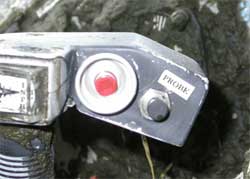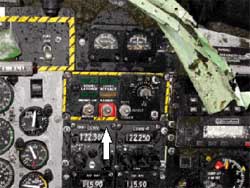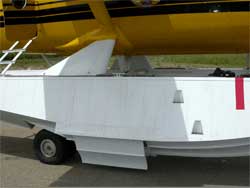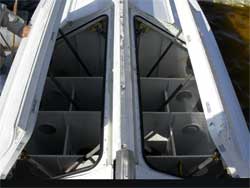Loss of Control on Water
Ministry of Natural Resources
de Havilland DHC-6-300 (Amphibious) C-GOGC
Lake Wicksteed, Ontario
The Transportation Safety Board of Canada (TSB) investigated this occurrence for the purpose of advancing transportation safety. It is not the function of the Board to assign fault or determine civil or criminal liability. This report is not created for use in the context of legal, disciplinary or other proceedings. See Ownership and use of content. Masculine pronouns and position titles may be used to signify all genders to comply with the Canadian Transportation Accident Investigation and Safety Board Act (S.C. 1989, c. 3).
Summary
The de Havilland DHC-6-300 amphibious aircraft (registration C-GOGC, serial number 750) with a single pilot on board was performing firefighting operations in the vicinity of Lake Wicksteed, approximately 10 nautical miles north of Hornepayne, Ontario. The aircraft was scooping water from Lake Wicksteed for the nearby fire. The lake is approximately 7300 feet in length with gentle rising terrain along its shoreline. This was the third scooping from the lake, and the approach was flown in an easterly direction in light wind conditions. The pilot performed the inbound checks, lowered the water probes to begin filling the float water tanks, and touched down on the lake. Within a short time, he observed water spraying from the overflow vents located on top of the floats, indicating that the tanks were filled to capacity. He pressed a button on the yoke to retract the probes, and the aircraft immediately nosed over into the lake in a wings-level attitude and began to sink. The accident occurred at approximately 1800 eastern daylight time.
The pilot extricated himself from the aircraft and held on to the side of the partially submerged aircraft. A witness to the occurrence immediately boarded a powered, aluminum boat and went to assist the pilot, while a second witness travelled to Hornepayne to notify the authorities and emergency services. Once the pilot reached the shore, he was taken to a nearby cottage where he remained until emergency services arrived. The aircraft came to rest on the bottom of the shallow lake in an inverted attitude with the floats above the surface of the water.
Factual information
The Ministry of Natural Resources (MNR) operates five de Havilland DHC-6 Twin Otters for firefighting operations. The aircraft are equipped with amphibious Wipline 13000 floats, modified with water holding tanks and probes. The probes, located on the bottom of the floats, are extended and provide the filling points for the water tanks. The water bomb doors, two on the bottom of each float, and the probes are electro-hydraulically operated and share hydraulic pressure and fluid with the aircraft's hydraulic system. They are controlled by two push-button switches located side-by-side on the left yoke. To prevent inadvertent operation of the bomb doors, the bomb door push-button switch is covered with a hinged plate that must be raised to expose the button. The door system also incorporates a door armed switch on the centre panel that must be selected ON for the system to be active.
Position indication for the doors and probes is provided by six green lights on the centre panel. When the six lights are illuminated, they indicate that the bomb doors are retracted, the probes are stowed, and the door jacks are fully retracted. There is an amber light co-located in the centre panel with the green lights and, when illuminated, indicates that the door armed switch is ON. A separate amber light on the panel directly in front of the pilot illuminates if either the doors or probes are extended. A red light located directly above the amber light illuminates and a horn sounds if the bomb doors become open without being selected.
The water bombing system incorporates a dump lever that, in an emergency, allows the water to eject through the mechanical free-fall capability of the doors. A hydraulic hand pump retracts the doors if the aircraft's electric hydraulic pump fails.
There is a probe control switch toggle switch located on the centre panel. At the request of flight crews, a push button probe switch was added to the control yoke. Once the modification was complete, the probes were controlled by the push button switch installed adjacent to the bomb door push button switch on the yoke (Photo 1). The pilots could now operate the doors and probes by moving the thumb between the two switches, while maintaining both hands on the yoke. The bomb door push button switch and probe switch are similar in size and type.
During a scooping operation, the pilot presses the push button probe switch to extend the probes. After touchdown, engine power is advanced and yoke back pressure is applied to maintain the planing attitude while the tanks are filling. When the tanks are full, the probe button is pressed a second time and the probes retract. After lift-off, when the aircraft attains a positive rate of climb, the bomb door armed switch on the centre panel is selected ON, and the bomb doors can then be opened by the bomb door push button switch on the yoke.
Prior to scooping, the bomb door armed switch on the centre panel must be selected OFF to prevent the inadvertent activation of the bomb door open operation if the bomb door push button switch is pressed. The armed switch should be ON only after the scooping operation is complete and the floats have cleared the water surface. After the occurrence, when the position of the centre panel switches were examined, the door armed switch was found in the ON position.
On initial examination of the aircraft, the right bomb doors were found in the extended position. The left bomb doors were closed, but there were indications of damage where the trailing edge of the doors and the float interface. When the aircraft was raised to an upright position, both sets of left bomb doors free fell to the extended position. The probes were fully extended.
On initial examination of the aircraft, the right bomb doors were found in the extended position. The left bomb doors were closed, but there were indications of damage where the trailing edge of the doors and the float interface. When the aircraft was raised to an upright position, both sets of left bomb doors free fell to the extended position. The probes were fully extended.
The DHC-6 Standard Operating Procedures (SOP), Pre-Water Pick-up procedures, state that the pilot will complete the Vital Action checklist and a short final gear and bomb door status check prior to each scooping operation. One of the Vital Action checks is to select the bomb door arming switch OFF. The last check on the list is a short-final, visual gear check.
The DHC-6 SOP section for Pre-Water Pick-up emphasizes the importance of completing the Vital Action checklist and Short-Final checks. There is a warning to pilots not to abbreviate the checklists in order to minimize the turn around time during the scooping operation. It further states that it is the pilot's responsibility to ensure that sufficient time and space are provided to complete all required checks.
The pilot held a valid airline transport pilot licence. He had accumulated a total flying time of approximately 22 000 hours, with 8500 hours on type. The pilot recently completed a Twin Otter pilot recurrent course, the sea survival and underwater escape training course, and the DHC-6 amphibious water bomber competency test. He was familiar with the firefighting operations and this type of aircraft from previous employment with the MNR.
Weather information was obtained from two different locations. Geraldton, Ontario, located approximately 135 miles west of Hornepayne, was reporting a mostly-cloudy sky condition, 15 miles visibility, and wind at 18 to 20 miles per hour. Kapuskasing, located approximately the same distance east of Hornepayne, was reporting an overcast sky condition, 15 miles visibility, and wind at 9 miles per hour.
Analysis
The environmental conditions at the time of the accident were favourable for the type of operation being conducted. The pilot was experienced and current on the type of aircraft and he was familiar with the operation.
During the approach, the Vital Action checklist was not completed as per the SOPs, and the bomb door armed switch was left in the ON position. After completing the scooping operation, the pilot intended to retract the probes by pressing the probe switch but inadvertently pressed the adjacent bomb door switch. Since this system remained armed from the previous bombing run, the doors extended into the water. The drag from the doors and the water rushing into the floats through the door openings resulted in the aircraft nosing over. The proximity of the probe and bomb door push button switches and the missing cover plate on the bomb door switch increased the likelihood of selecting the bomb door switch instead of the probe switch.
Findings as to Causes and Contributing Factors
- Ministry of Natural Resources DHC-6 SOPs were not followed, and the Vital Action checklist was not fully completed during the approach. As a result, the bomb door armed switch on the centre panel was not selected OFF after the previous water bombing run and prior to the scooping operation.
- After completing the water scooping operation, the pilot unintentionally selected the bomb door push button switch instead of the adjacent probe switch. Because the bomb door armed switch on the centre panel was left ON, the bomb doors extended into the water. Drag from the doors and the water rushing into the door openings resulted in the aircraft nosing over in the water.
- The hinged cover plate for the bomb door push button switch was not re-installed following maintenance to replace the push button switch. The push button was exposed, making an inadvertent selection more likely.
Safety action
The MNR has verified that every Twin Otter aircraft in their fleet is equipped with the cover plate over the bomb door push button switch. The MNR will ensure that any future modifications to aircraft will be standardized to decrease the potential for inadvertent operation of systems.
This report concludes the Transportation Safety Board's investigation into this occurrence. Consequently, the Board authorized the release of this report on .



